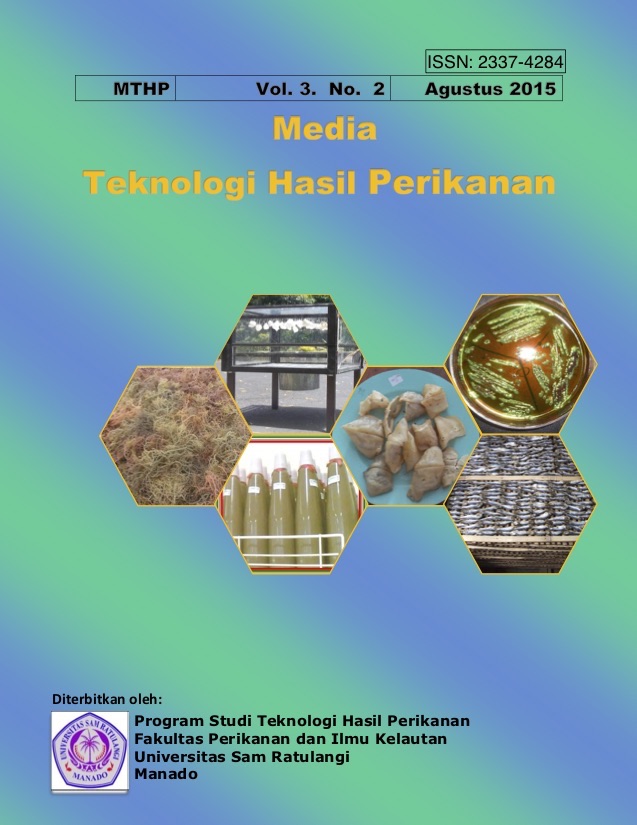ANALISA KADAR AIR, pH, ORGANOLEPTIK, DAN KAPANG PADA PRODUK IKAN TUNA (Thunnus Sp) ASAP, DI KELURAHAN GIRIAN BAWAH, KOTA BITUNG, SULAWESI UTARA
DOI:
https://doi.org/10.35800/mthp.3.2.2015.10355Keywords:
Tuna (Thunnus sp) Smoke, Analysis of Moisture, pH, Appearance, Kapang, Tuna Asap, Analisa Kadar Air, OrganoleptikAbstract
Fish is a source of food that is needed by humans because it contains a lot of protein. Protein and high water, fish including highly perishable commodity. Therefore, it is necessary to inhibit the process of decay by means of preservation and processing. Fumigation is a way of processing or preservation by utilizing a combination of drying treatment and the provision of chemical compounds from the combustion of natural fuel. This study aims to determine the water content, pH, Appearance and Kapang on products tuna (Thunnus sp) smoke drawn from industry Girian households in villages under the city of Bitung, North Sulawesi. 0 day, 2 days and 4 days of storage at room temperature. The research is descriptive exploratory method, which collects data fact that has been available in the field via the recording and systematic observation in detail and then analyzed the data based on qualitative and quantitative data. The parameters used in the study is testing Water content, pH Test, Test Organoleptik and Fungus. The results obtained from the four test parameters, the value of the highest water content (52.3%), the lowest (29%); The highest pH value of 6.23, the lowest was 5.92; organoleptic value (the appearance of) the highest (7.06), the lowest (2.73); organoleptic values (smell) the highest (7.6); Lowest (1); value organoleptic (taste) the highest (7.66); Lowest (1); organoleptic value (texture) teringgi (6.93); the lowest (2.6); the total value of mold colonies (CFU/g) is the highest (1620); the lowest (40).
Keyword: Tuna (Thunnus sp) Smoke, Analysis of Moisture, pH, Appearance, Kapang.
Â
Ikan merupakan salah satu sumber makanan yang sangat dibutuhkan olehmanusia karena banyak mengandung protein. Kandungan protein dan air yang cukup tinggi, ikan termasuk komoditi yang sangat mudah busuk. Oleh karena itu, diperlukan upaya untuk menghambat proses pembusukan dengan cara pengawetan dan pengolahan. Pengasapan merupakan suatu cara pengolahan atau pengawetan dengan memanfaatkan kombinasi perlakuan pengeringan dan pemberian senyawa kimia dari hasil pembakaran bahan bakar alami. Penelitian ini bertujuan untuk mengetahui Kadar air, pH, Organoleptik dan Kapang pada produk ikan tuna (Thunnus sp) asap yang diambil dari industri rumah tangga di kelurahan girian bawah Kota Bitung Sulawesi Utara. Selama 0 hari, 2 hari, dan 4 hari, penyimpanan pada suhu ruang. Penelitian yang digunakan adalah metode eksploratif deskriptif, yaitu mengumpulkan data fakta yang telah tersedia dilapangan melalui pencatatan dan pengamatan secara terperinci dan sistematik kemudian dilakukan analisa data berdasarkan data kualitatif dan kuantitatif. Parameter yang digunakan dalam penelitian adalah Uji Kadar Air, Uji pH, Uji Organoleptik dan Kapang. Hasil penelitian yang diperoleh dari 4 parameter uji, diperoleh nilai kadar air tertinggi (52,3%), yang terendah (29,%); nilai pH tertinggi 6,23, terendah 5,92; nilai organoleptik (kenampakan) tertinggi (7,06), terendah (2,73); nilai organoleptik (bau) tertinggi (7,6); terendah (1); nilai organoleptik (rasa) tertinggi (7,66); terendah (1); nilai organoleptik (tekstur) teringgi (6,93); terendah (2,6); nilai total koloni kapang (CFU/gr) tertinggi (1620); terendah (40).
Kata Kunci: Ikan Tuna (Thunnus sp) Asap, Analisa Kadar Air, pH, Organoleptik, Kapang.
Downloads
Published
How to Cite
Issue
Section
License
Authors who publish with this journal agree to the following terms:
- Authors retain copyright and grant the journal right of first publication with the work simultaneously licensed under a Creative Commons Attribution License that allows others to share the work with an acknowledgement of the work's authorship and initial publication in this journal.
- Authors are able to enter into separate, additional contractual arrangements for the non-exclusive distribution of the journal's published version of the work (e.g., post it to an institutional repository or publish it in a book), with an acknowledgement of its initial publication in this journal.
- Authors are permitted and encouraged to post their work online (e.g., in institutional repositories or on their website) prior to and during the submission process, as it can lead to productive exchanges, as well as earlier and greater citation of published work (See The Effect of Open Access).






